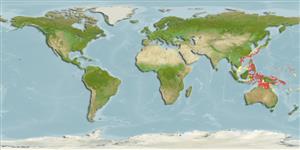Classification / Names
Common names | Synonyms | Catalog of Fishes (gen., sp.) | ITIS | CoL | WoRMS | Cloffa
Actinopterygii (ray-finned fishes) >
Perciformes (Perch-likes) >
Gobiidae (Gobies) > Gobiinae
Etymology: Asterropteryx: Greek, a = with + Greek, sterros, -a, -on = consistent + Greek, pteryx = fin (Ref. 45335); senoui: Named for H. Senou, Kanagawa Prefectual Museum of Natural History, Japan.
Environment / Climate / Range
Ecology
Marine; demersal; depth range 15 - 65 m (Ref. 90102). Temperate, preferred ?
Distribution
Countries | FAO areas | Ecosystems | Occurrences | Point map | Introductions | Faunafri
Western Pacific: Ryukyus, Japan and Indonesia.
Size / Weight / Age
Maturity: Lm ? range ? - ? cm
Max length : 2.5 cm SL male/unsexed; (Ref. 75136); 2.4 cm SL (female)
Short description
Morphology | Morphometrics
Dorsal
spines
(total): 7;
Dorsal
soft rays
(total): 9-10;
Anal
spines: 1;
Anal
soft rays: 9;
Vertebrae: 26. This species differs from the other species of the spinosa complex in having the following set of characters: cheek spines 6-10; all are short and the similar in size, length of longest spine 1.6-2.2% SL; first dorsal fin with no filamentous spines; distinct black spot on first dorsal fin absent; caudal fin base with a small vertically-elongate ovoid black spot; head and body, except for minute, dusky and slightly faded orange or yellow dots, have no vivid reddish orange spots ; underneath the eye is a distinct, narrow ventrally pointed vertical black bar (Ref. 75136); characterized further by absence of prolonged spines; longitudinal scale series 23-24; ctenoid scales on body, becoming cycloid anterior to pelvic and pectoral fins; rounded caudal fin; depth of body 4.0-4.4 in SL (Ref. 90102).
Occurs in coral-reef slopes, in protected bays, and found solitary on muddy or sandy-mud bottoms with dead-coral rubbles In the area. Associated with Its congener, A. atripes (Ref. 75136).
Life cycle and mating behavior
Maturity | Reproduction | Spawning | Eggs | Fecundity | Larvae
Shibukawa, K. and T. Suzuki, 2007. Two new species of the cheek-spine goby genus Asterropteryx (Perciformes: Goiidae: Gobiinae) from the western Pacific. Bull. Natl. Mus. Nat. Sci., Ser. A, Suppl 1:109-121. (Ref. 75136)
IUCN Red List Status (Ref. 115185)
CITES (Ref. 94142)
Not Evaluated
Threat to humans
Harmless
Human uses
More information
CountriesFAO areasEcosystemsOccurrencesIntroductionsStocksEcologyDietFood itemsFood consumptionRation
Common namesSynonymsMetabolismPredatorsEcotoxicologyReproductionMaturitySpawningFecundityEggsEgg development
Age/SizeGrowthLength-weightLength-lengthLength-frequenciesMorphometricsMorphologyLarvaeLarval dynamicsRecruitmentAbundance
ReferencesAquacultureAquaculture profileStrainsGeneticsAllele frequenciesHeritabilityDiseasesProcessingMass conversion
Tools
Special reports
Download XML
Internet sources
